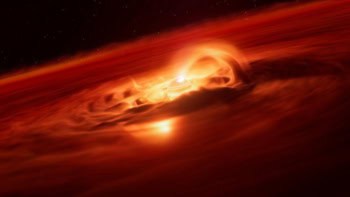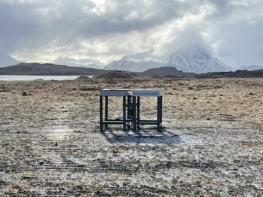
Direct observations of dark matter – the substance thought to account for 80% of matter in the universe – are sketchy, at best. Some experiments have found what seem like dark-matter signals, while others looking within the same parameter range have found nothing. Yet there is a hypothetical candidate for dark matter, known as “inelastic” dark matter, that could reconcile such results – and now two teams of physicists have proposed new ways to see if it exists.
The story of inelastic dark matter begins over a kilometre beneath Gran Sasso mountain in Italy, which is home to the underground DAMA experiment. Here, a bank of detectors watches out for the flash of light that is expected when a dark-matter particle strikes a nucleus within the experiment. Although such collisions are very rare, in theory there should be more flashes in summer, when the Earth is orbiting against the prevailing “wind” of dark matter in our galaxy.
The DAMA team claimed the first such signature in 2000, and over the subsequent decade has steadily increased its precision. In its most recent analysis (available at arXiv:1002.1028), the researchers claim evidence for dark-matter particles at a statistical significance of 8.9 sigma – or, to put it another way, about as precise as one can hope to expect.
No matching signals
These results have failed to convince many physicists, however. Part of the problem is that there could be some other factor that modulates with the seasons, thereby imitating the much sought-after dark-matter signal. But more troubling is that several other direct-detection experiments – CDMS in the US or ZEPLIN in the UK, for instance – have found no matching signals using different detectors.
Regardless of the details of estimating the amount of dark matter, it’s quite an interesting scenario for looking for evidence of inelastic dark matter Matthew McCullough, University of Oxford
To get round this, some physicists have proposed different types of dark matter that would interact only with DAMA’s detectors. One of these, inelastic dark matter, was put forward in 2001 by David Smith at the University of California at Berkeley and Neal Weiner at the University of Washington. Unlike normal, “elastic” dark matter, inelastic dark matter would get heavier when it hits an atomic nucleus of sufficient mass. So because sodium iodide has the most massive nuclei, only DAMA would be able to give inelastic dark matter the mass jump to enable it to scatter and produce the tell-tale flashes.
Now, two independent groups have tried to find ways to spot evidence for inelastic dark matter somewhere far outside the lab – namely in old white dwarf stars. White dwarves are the dim, compact forms that the vast majority of stars adopt in their latter years, and as they get older they cool down. The oldest and coolest ones tend to reside in the centres of galaxies, or in regions of high dark-matter density.
Warming old white dwarfs
The two groups – one comprising Dan Hooper and colleagues at Fermilab in the US; and the other being Matthew McCullough at the University of Oxford and Malcolm Fairbairn at King’s College London in the UK – have calculated how dark matter should interact with an old white dwarf’s atomic nuclei as it is accelerated inwards by the star’s huge gravitational forces. According to their calculations, inelastic dark matter should interact much more strongly than elastic dark matter, which means that much more of it would end up being absorbed by the star. And this added mass would in turn mean that the star’s temperature is held a little higher, at around 7000 K as opposed to 3000 K.
It may be that the true importance of these works will come after we know what the dark matter is, which is a truly exciting prospect Neal Weiner, New York University
“If you looked at [a dense dark matter region] and, instead of seeing very cold white dwarves, you saw white dwarves at nothing below, say, six or seven thousand Kelvin, then you might say, huh, maybe these white dwarves are cooling but they’ve hit this bottom floor where they can’t cool any further, because inelastic dark matter is heating them up,” explains Hooper. “And that would be evidence of the [inelastic dark matter] picture.”
Both groups suggest a search for unusually warm white dwarves as a means to find evidence for inelastic dark matter, although there are differences between their studies. Whereas McCullough and Fairbairn have focused on close regions of tightly bound stars known as globular clusters, Hooper’s group believes that there are higher densities of dark matter in galactic centres, which would make the search for the white dwarves easier. Still, as McCullough point out, the issue isn’t settled. “Regardless of the details of estimating the amount of dark matter, it’s quite an interesting scenario for looking for evidence of inelastic dark matter,” he adds.
Weiner – now at New York University – agrees with Hooper’s group that galactic centres present the most promising region to test the hypothesis. However, he also thinks that observations of old white dwarves could instead be used to map distributions of dark matter once direct-detection experiments have found the true nature of dark-matter particles. “Rather than being tests of theories of dark matter, [white dwarves] may become excellent probes of the structure of the galaxy’s dark matter halo,” he says. “It may be that the true importance of these works will come after we know what the dark matter is, which is a truly exciting prospect.”
Preprints of the studies can be found at arXiv: 1001.2737 and arXiv:1002.0005.



